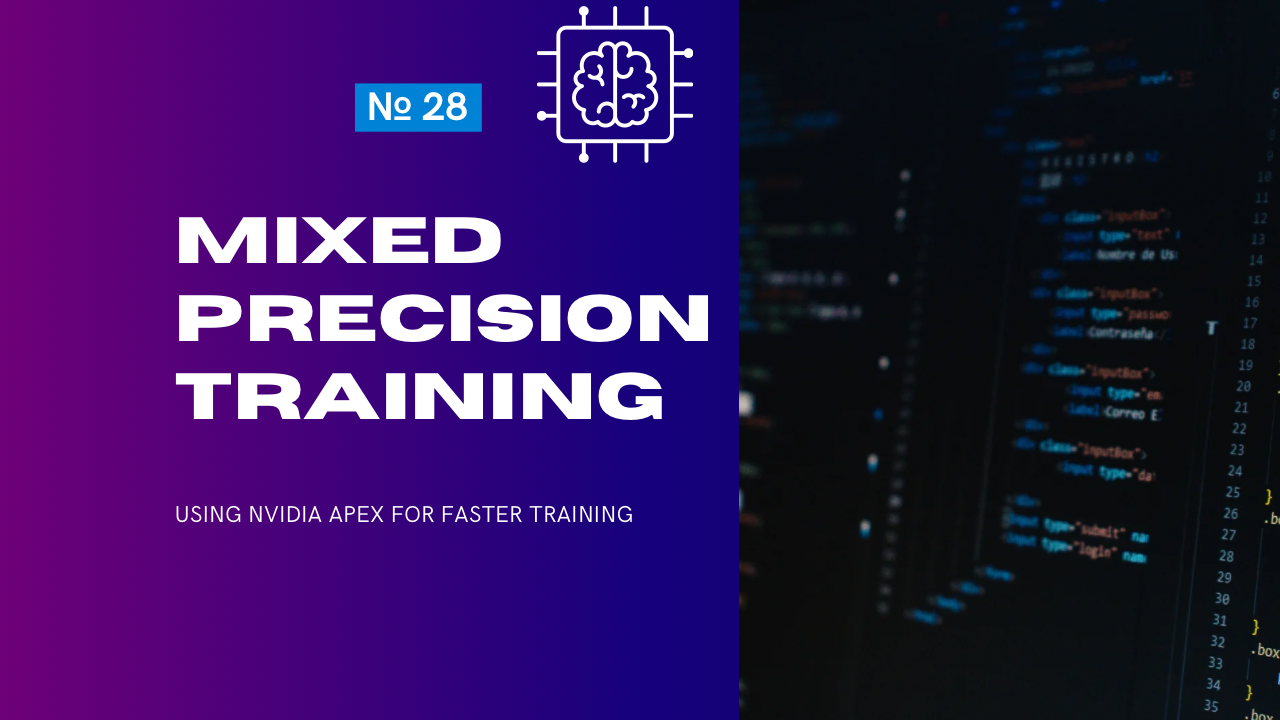Mixed precision training is a technique that uses both 16-bit (half-precision) and 32-bit (single-precision) floating-point computations to accelerate deep learning training while reducing memory usage. NVIDIA’s Apex library simplifies the implementation of mixed precision training in PyTorch, making it easy to leverage hardware accelerators like NVIDIA Tensor Cores for faster and more efficient training.
Why Use Mixed Precision Training?
- Speed-Up Training:
- Tensor Cores in NVIDIA GPUs are optimized for 16-bit operations, leading to faster matrix multiplications and convolutions.
- Reduced Memory Usage:
- Lower precision reduces memory requirements, allowing larger batch sizes or models.
- Minimal Accuracy Loss:
- Modern hardware and algorithms mitigate the accuracy loss typically associated with lower precision.
Key Concepts
- FP16 (Half-Precision):
- Represents numbers with 16 bits, reducing memory and computational overhead.
- Used for most matrix multiplications during training.
- FP32 (Single-Precision):
- Standard 32-bit precision for deep learning.
- Used for operations requiring high numerical stability (e.g., loss calculations, weight updates).
- Loss Scaling:
- A technique to prevent underflow when using FP16 by scaling up small gradients during backward passes.
Steps to Implement Mixed Precision Training with NVIDIA Apex
1. Install NVIDIA Apex
Install NVIDIA Apex via GitHub (requires compatible CUDA and PyTorch versions):
git clone https://github.com/NVIDIA/apex.git
cd apex
pip install -v --no-cache-dir ./2. Prepare Your Training Script
Apex provides an easy-to-use API for mixed precision training. Here’s how to integrate it into a typical PyTorch training workflow.
3. Code Example: Using Apex
import torch
import torch.nn as nn
import torch.optim as optim
from torchvision import models
from apex import amp
# Check if GPU is available
device = torch.device("cuda" if torch.cuda.is_available() else "cpu")
# Define model, loss, and optimizer
model = models.resnet18(pretrained=False).to(device)
criterion = nn.CrossEntropyLoss()
optimizer = optim.SGD(model.parameters(), lr=0.01, momentum=0.9)
# Initialize mixed precision with Apex
model, optimizer = amp.initialize(model, optimizer, opt_level="O1")
# Example training loop
for epoch in range(5):
for inputs, labels in dataloader: # Assume `dataloader` is defined
inputs, labels = inputs.to(device), labels.to(device)
# Forward pass
outputs = model(inputs)
loss = criterion(outputs, labels)
# Backward pass
optimizer.zero_grad()
with amp.scale_loss(loss, optimizer) as scaled_loss:
scaled_loss.backward()
# Update weights
optimizer.step()Apex Optimization Levels
| Opt Level | Description |
|---|---|
| O0 | Full FP32 training (no mixed precision). |
| O1 | Mixed precision with automatic casting of operations (recommended for most cases). |
| O2 | FP16 training with FP32 master weights for higher precision in weight updates. |
| O3 | Pure FP16 training (may result in numerical instability; use only if you know your model supports it). |
4. Advanced Apex Features
a. Gradient Accumulation
Use gradient accumulation to train larger models by splitting large batches across multiple smaller iterations.
accumulation_steps = 4
optimizer.zero_grad()
for i, (inputs, labels) in enumerate(dataloader):
inputs, labels = inputs.to(device), labels.to(device)
outputs = model(inputs)
loss = criterion(outputs, labels)
# Scale loss and backpropagate
with amp.scale_loss(loss, optimizer) as scaled_loss:
scaled_loss.backward()
# Update weights after every accumulation_steps
if (i + 1) % accumulation_steps == 0:
optimizer.step()
optimizer.zero_grad()b. Multi-GPU Training
Use Apex with Distributed Data Parallel (DDP) for multi-GPU training:
from torch.nn.parallel import DistributedDataParallel as DDP
# Wrap the model for DDP
model = DDP(model)
# Initialize mixed precision
model, optimizer = amp.initialize(model, optimizer, opt_level="O1", distributed=True)Performance Benefits
| Metric | FP32 Training | Mixed Precision Training |
|---|---|---|
| Training Speed | Slower | 1.5x to 3x faster |
| Memory Usage | High | 2x to 3x lower |
| Batch Size | Smaller | Larger (fits in GPU memory) |
Best Practices
- Use Opt Level O1:
- Provides the best balance between performance and numerical stability.
- Enable Gradient Clipping:
- Prevent exploding gradients during mixed precision training.
torch.nn.utils.clip_grad_norm_(amp.master_params(optimizer), max_norm=1.0)- Monitor Training:
- Keep an eye on the loss and gradients to ensure stability during training.
- Validate on FP32:
- Convert the model back to FP32 for validation and inference to avoid precision-related issues.
Limitations
- Numerical Instability:
- Some models or layers may experience instability with FP16 precision.
- Use loss scaling or fallback to FP32 for specific operations if necessary.
- Compatibility:
- Apex requires CUDA-compatible GPUs with Tensor Core support (e.g., NVIDIA Volta, Turing, or Ampere architectures).
- Framework-Specific:
- Apex is designed specifically for PyTorch. Alternatives like TensorFlow’s
mixed_precisionAPI are needed for TensorFlow models.
Alternatives to Apex
- PyTorch Native AMP:
- PyTorch now includes a built-in Automatic Mixed Precision (AMP) module, which simplifies mixed precision training without Apex.
with torch.cuda.amp.autocast():
outputs = model(inputs)
loss = criterion(outputs, labels)
scaler = torch.cuda.amp.GradScaler()
scaler.scale(loss).backward()
scaler.step(optimizer)
scaler.update()- TensorFlow Mixed Precision:
- TensorFlow provides a mixed precision API for Keras models.
from tensorflow.keras.mixed_precision import experimental as mixed_precision
policy = mixed_precision.Policy('mixed_float16')
mixed_precision.set_policy(policy)Conclusion
Mixed precision training with NVIDIA Apex is a powerful technique for accelerating model training and reducing memory consumption. By leveraging Tensor Cores and the flexibility of Apex’s API, developers can scale their models and train them faster while maintaining accuracy. For new projects, consider using PyTorch’s native AMP for similar benefits with less setup complexity.
